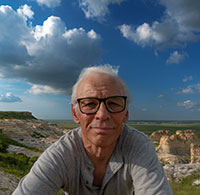Sandhill crane inflight.
(photo by: ©Dan Peak)
Photographing the spring migration of Sandhill Cranes had been on my list for a while. This year I made the trip, taking along my new Sony A1 II and the Sony 600mm f/4 lens for its first extended use in the field. I signed up for a photo tour hosted by the Crane Trust and guide Cheryl Opperman along the Platte River in central Nebraska.
The Crane Trust is a conservation nonprofit that protects and maintains habitat along the Big Bend Region of the Platte River, a key stopover point for hundreds of thousands of Sandhill Cranes each spring. Their guided photo tours include access to well-positioned blinds, comfortable lodging, and on-site staff who know both the birds and the river well.
Our group had two morning and two evening sessions in the blinds. Each blind was roomy, solidly built, and gave us clear views of the river and the cranes. On the first evening, the birds roosted farther out, so I focused on silhouette shots against the sunset. The light was good, and while the cranes were distant, it was still worth the time.
The following morning we were in a different blind, hoping the birds would be closer. They were. A slow sunrise built up over the water as the cranes flew in and began calling, feeding, and settling. It was a good chance to try out autofocus tracking and eye detection on the A1 II with some real targets.
That night, we returned to the original blind. The cranes came in much closer this time, though there wasn’t much movement once they landed. Still, the light was workable and we had clear views.
Then came the final morning. That final morning started in near darkness, with a pale, nearly full moon hanging low in the western sky. As it began to set, the light softened and the river filled with motion — cranes waking, calling, stretching wings. I turned the camera away from the birds briefly to frame the moon as it dropped behind the cottonwoods, just above the cranes still gathered on the sandbars. It was a rare chance to combine the landscape, the birds, and that moon in one quiet frame.
Not long after, a beautiful golden light spread across the river as the sun rose. Cranes began lifting off and flying right over the blind — close enough for nearly full-frame shots. The Sony A1 II tracking stayed locked on, even with birds coming in fast and low. It was the kind of moment where everything came together: timing, light, and gear. As the morning went on, a group of cranes started dancing not far from the blind, ending the session on a high note. Quite the ending to an unforgettable adventure.
What stood out most to me on this trip was the camera. The A1 II found and held focus fast. Tracking was solid, even in low light. I used the bird eye autofocus setting, and it felt almost too easy — especially for someone who used to follow-focus by hand with a film body. But I’ll take it. The camera did its job and let me concentrate on timing and composition.
This was the first time I’d spent multiple full days using the A1 II in real-world conditions. I was especially impressed with how it handled in a blind: quick to wake, reliable in back-button focus, and responsive even with gloves on in the cold mornings. The blackout-free EVF made it easy to stay with birds in flight, and I could fire off bursts without losing track of what was happening.
The Sony 600mm f/4 paired well with it, obviously. It’s a heavy combo, but workable on a gimbal in the blind.
I set up one of the custom buttons to quickly switch between a custom area tracking mode and large spot tracking, which helped a lot when birds were bunched or flying solo. Still dialing in the pre-capture settings. I’ve assigned it to another custom button that I can reach quickly to toggle on and off. I failed on several occasions to turn it off when I didn’t need it — and depending on your settings, that can result in way more frames than you want to review later. Pre-capture is powerful, but it comes with a cost: shooting a lot with it will burn through your battery faster than expected. Take more batteries than you think you’ll need. It’s a work in progress, but worth figuring out.
There’s always something to learn, but after this trip, I felt like I had a good handle on the A1 II. If anything, the camera was ahead of me. Now it’s just a matter of catching up to what it can do.
The Crane Trust tour was well run, and the people — both staff and fellow photographers — made the experience better.
Further Reading






